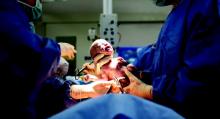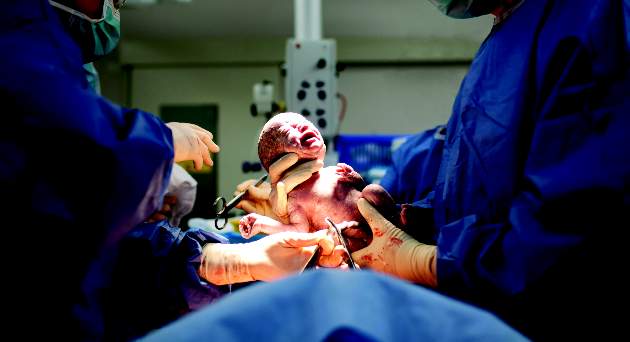User login
Newborns delivered by cesarean section have different microbial colonization patterns than babies delivered vaginally, and several studies have suggested that their immunologic and metabolic development may be disadvantaged as a result.
Preliminary results from a recent proof-of concept study in 18 babies, published online in Nature Medicine, showed that transferring vaginal fluid to newborns shortly after delivery by C-section resulted in microbiome profiles resembling those of babies delivered vaginally (doi: 10.1038/nm.4039).
But it is still unknown whether promoting colonization in this way approximates the microbial transfer that occurs during labor, or whether it affects later health outcomes in these infants. The researchers, led by Maria G. Dominguez-Bello, Ph.D., of New York University in New York City, stressed in their study that considerably more time and research are needed to answer these questions.
Still, as the practice gains more attention in the press and in parenting blogs, patients are asking clinicians to perform vaginal fluid transfer or “vaginal seeding” following C-sections.
BMJ highlights concerns
A Feb. 23 editorial in the BMJ stressed that clinicians not recommend vaginal seeding, because of insufficient evidence and because of the potential for unrecognized infections to be transmitted from mother to newborn (BMJ. 2016;352:i227. doi: 10.1136/bmj.i227).
“It might seem reasonable to perform this simple and cheap procedure, even without clear evidence of benefit, but only if we can be sure that it is safe,” wrote a group of clinicians led by Dr. Aubrey J. Cunnington of Imperial College London. For now, they wrote, breastfeeding and avoidance of unnecessary antibiotics should be stressed to promote early microbiome development.
But even if clinicians and hospitals refuse to perform seeding – which can be done by placing gauze in the vagina prior to delivery and then using it to swab the newborn – “mothers can easily do it themselves,” Dr. Cunnington and colleagues said in their editorial.
The potential demand for vaginal seeding raises a host of issues, according to three U.S.-based ob.gyns., all of whom said they agree with the caution expressed in the BMJ editorial, but have varying approaches to how to advise their patients.
“From a clinician’s point of view, I think it’s really important to not wait for a woman to say, ‘Should I do this?’ but instead for doctors to proactively say, ‘You may have read about this and we don’t recommend it,’ ” Dr. Lauren Streicher,of Northwestern University, Chicago, said in an interview.
“The real concern is that since you don’t need a doctor to do it, mothers are going to take it upon themselves,” Dr. Streicher said, particularly as the practice gains more attention in the lay press, or if vaginal seeding gets endorsed or promoted by someone famous, something she said is all but inevitable.
Patients need to be aware that there are risks inherent in either mode of delivery, Dr. Streicher noted, and vaginal delivery comes with the risk of transmitting undiagnosed group B streptococcus, chlamydia, gonorrhea, or herpes viruses.
Dr. Layne Kumetz, an ob.gyn. in Beverly Hills, Calif., said in an interview that her patients tend to be educated and “early adopters” when it comes to medical trends. She said she has already received patient queries about vaginal seeding and counseled patients on the potential risks. As a mother herself, she has also noticed active discussion about vaginal seeding on parenting blogs.
But Dr. Kumetz said that pending much more study, “routine practicing of the procedure is simply not appropriate.”
She added, “The long term implications about whether this will alter the health of newborns have not been determined, whether this is a safe procedure has not been determined, [and] what the proper protocol should be in terms of women wishing to have this procedure performed has not been determined.”
The women in the pilot study who had used vaginal seeding, Dr. Kumetz noted, had been carefully selected and screened, had been treated with antibiotics prior to their C-sections, and were group B strep negative. In the general population, meanwhile, nearly a third of patients are group B positive, she said.
Dr. Kumetz said she would not bring up the seeding with patients who don’t ask, nor was it something that the hospitals she’s working with are willing to perform.
Emphasize alternatives
Dr. Eliza Bennett of the University of Wisconsin–Madison said that requests for vaginal seeding had become more frequent, even months before the pilot study was published. The procedure is allowed at her hospital, but is available only by request.
Dr. Bennett stressed that she, like Dr. Kumetz, does not discuss the practice with patients unless they bring it up themselves. For women who do request it, nurses have been trained in the practice, she said, and “we have established really strict exclusion criteria,” including repeat screening for group B strep, HIV, genital herpes, and sexually transmitted infections during pregnancy.
Dr. Bennett said she would much rather emphasize the safer, evidence-based practices already in place at her hospital to promote microbiome development in C-section newborns. These include delaying the first bath until after 12 hours, placing babies directly on mothers’ skin in the operating room in the first minutes post delivery, and “offering the ability for moms to breastfeed right in the OR,” she said.
Like Dr. Streicher and Dr. Kumetz, Dr. Bennett said she’s not expecting to see data resolving the questions about the risks and benefits of vaginal seeding anytime soon.
“Instead of focusing on vaginal seeding, we should continue to focus our efforts on decreasing cesarean delivery rates and ensuring and encouraging appropriate candidates to have the opportunity to have a trial of labor after cesarean delivery,” she said.
Avoiding C-section, she added, “confers multiple maternal and fetal benefits beyond the microbiome.”
Newborns delivered by cesarean section have different microbial colonization patterns than babies delivered vaginally, and several studies have suggested that their immunologic and metabolic development may be disadvantaged as a result.
Preliminary results from a recent proof-of concept study in 18 babies, published online in Nature Medicine, showed that transferring vaginal fluid to newborns shortly after delivery by C-section resulted in microbiome profiles resembling those of babies delivered vaginally (doi: 10.1038/nm.4039).
But it is still unknown whether promoting colonization in this way approximates the microbial transfer that occurs during labor, or whether it affects later health outcomes in these infants. The researchers, led by Maria G. Dominguez-Bello, Ph.D., of New York University in New York City, stressed in their study that considerably more time and research are needed to answer these questions.
Still, as the practice gains more attention in the press and in parenting blogs, patients are asking clinicians to perform vaginal fluid transfer or “vaginal seeding” following C-sections.
BMJ highlights concerns
A Feb. 23 editorial in the BMJ stressed that clinicians not recommend vaginal seeding, because of insufficient evidence and because of the potential for unrecognized infections to be transmitted from mother to newborn (BMJ. 2016;352:i227. doi: 10.1136/bmj.i227).
“It might seem reasonable to perform this simple and cheap procedure, even without clear evidence of benefit, but only if we can be sure that it is safe,” wrote a group of clinicians led by Dr. Aubrey J. Cunnington of Imperial College London. For now, they wrote, breastfeeding and avoidance of unnecessary antibiotics should be stressed to promote early microbiome development.
But even if clinicians and hospitals refuse to perform seeding – which can be done by placing gauze in the vagina prior to delivery and then using it to swab the newborn – “mothers can easily do it themselves,” Dr. Cunnington and colleagues said in their editorial.
The potential demand for vaginal seeding raises a host of issues, according to three U.S.-based ob.gyns., all of whom said they agree with the caution expressed in the BMJ editorial, but have varying approaches to how to advise their patients.
“From a clinician’s point of view, I think it’s really important to not wait for a woman to say, ‘Should I do this?’ but instead for doctors to proactively say, ‘You may have read about this and we don’t recommend it,’ ” Dr. Lauren Streicher,of Northwestern University, Chicago, said in an interview.
“The real concern is that since you don’t need a doctor to do it, mothers are going to take it upon themselves,” Dr. Streicher said, particularly as the practice gains more attention in the lay press, or if vaginal seeding gets endorsed or promoted by someone famous, something she said is all but inevitable.
Patients need to be aware that there are risks inherent in either mode of delivery, Dr. Streicher noted, and vaginal delivery comes with the risk of transmitting undiagnosed group B streptococcus, chlamydia, gonorrhea, or herpes viruses.
Dr. Layne Kumetz, an ob.gyn. in Beverly Hills, Calif., said in an interview that her patients tend to be educated and “early adopters” when it comes to medical trends. She said she has already received patient queries about vaginal seeding and counseled patients on the potential risks. As a mother herself, she has also noticed active discussion about vaginal seeding on parenting blogs.
But Dr. Kumetz said that pending much more study, “routine practicing of the procedure is simply not appropriate.”
She added, “The long term implications about whether this will alter the health of newborns have not been determined, whether this is a safe procedure has not been determined, [and] what the proper protocol should be in terms of women wishing to have this procedure performed has not been determined.”
The women in the pilot study who had used vaginal seeding, Dr. Kumetz noted, had been carefully selected and screened, had been treated with antibiotics prior to their C-sections, and were group B strep negative. In the general population, meanwhile, nearly a third of patients are group B positive, she said.
Dr. Kumetz said she would not bring up the seeding with patients who don’t ask, nor was it something that the hospitals she’s working with are willing to perform.
Emphasize alternatives
Dr. Eliza Bennett of the University of Wisconsin–Madison said that requests for vaginal seeding had become more frequent, even months before the pilot study was published. The procedure is allowed at her hospital, but is available only by request.
Dr. Bennett stressed that she, like Dr. Kumetz, does not discuss the practice with patients unless they bring it up themselves. For women who do request it, nurses have been trained in the practice, she said, and “we have established really strict exclusion criteria,” including repeat screening for group B strep, HIV, genital herpes, and sexually transmitted infections during pregnancy.
Dr. Bennett said she would much rather emphasize the safer, evidence-based practices already in place at her hospital to promote microbiome development in C-section newborns. These include delaying the first bath until after 12 hours, placing babies directly on mothers’ skin in the operating room in the first minutes post delivery, and “offering the ability for moms to breastfeed right in the OR,” she said.
Like Dr. Streicher and Dr. Kumetz, Dr. Bennett said she’s not expecting to see data resolving the questions about the risks and benefits of vaginal seeding anytime soon.
“Instead of focusing on vaginal seeding, we should continue to focus our efforts on decreasing cesarean delivery rates and ensuring and encouraging appropriate candidates to have the opportunity to have a trial of labor after cesarean delivery,” she said.
Avoiding C-section, she added, “confers multiple maternal and fetal benefits beyond the microbiome.”
Newborns delivered by cesarean section have different microbial colonization patterns than babies delivered vaginally, and several studies have suggested that their immunologic and metabolic development may be disadvantaged as a result.
Preliminary results from a recent proof-of concept study in 18 babies, published online in Nature Medicine, showed that transferring vaginal fluid to newborns shortly after delivery by C-section resulted in microbiome profiles resembling those of babies delivered vaginally (doi: 10.1038/nm.4039).
But it is still unknown whether promoting colonization in this way approximates the microbial transfer that occurs during labor, or whether it affects later health outcomes in these infants. The researchers, led by Maria G. Dominguez-Bello, Ph.D., of New York University in New York City, stressed in their study that considerably more time and research are needed to answer these questions.
Still, as the practice gains more attention in the press and in parenting blogs, patients are asking clinicians to perform vaginal fluid transfer or “vaginal seeding” following C-sections.
BMJ highlights concerns
A Feb. 23 editorial in the BMJ stressed that clinicians not recommend vaginal seeding, because of insufficient evidence and because of the potential for unrecognized infections to be transmitted from mother to newborn (BMJ. 2016;352:i227. doi: 10.1136/bmj.i227).
“It might seem reasonable to perform this simple and cheap procedure, even without clear evidence of benefit, but only if we can be sure that it is safe,” wrote a group of clinicians led by Dr. Aubrey J. Cunnington of Imperial College London. For now, they wrote, breastfeeding and avoidance of unnecessary antibiotics should be stressed to promote early microbiome development.
But even if clinicians and hospitals refuse to perform seeding – which can be done by placing gauze in the vagina prior to delivery and then using it to swab the newborn – “mothers can easily do it themselves,” Dr. Cunnington and colleagues said in their editorial.
The potential demand for vaginal seeding raises a host of issues, according to three U.S.-based ob.gyns., all of whom said they agree with the caution expressed in the BMJ editorial, but have varying approaches to how to advise their patients.
“From a clinician’s point of view, I think it’s really important to not wait for a woman to say, ‘Should I do this?’ but instead for doctors to proactively say, ‘You may have read about this and we don’t recommend it,’ ” Dr. Lauren Streicher,of Northwestern University, Chicago, said in an interview.
“The real concern is that since you don’t need a doctor to do it, mothers are going to take it upon themselves,” Dr. Streicher said, particularly as the practice gains more attention in the lay press, or if vaginal seeding gets endorsed or promoted by someone famous, something she said is all but inevitable.
Patients need to be aware that there are risks inherent in either mode of delivery, Dr. Streicher noted, and vaginal delivery comes with the risk of transmitting undiagnosed group B streptococcus, chlamydia, gonorrhea, or herpes viruses.
Dr. Layne Kumetz, an ob.gyn. in Beverly Hills, Calif., said in an interview that her patients tend to be educated and “early adopters” when it comes to medical trends. She said she has already received patient queries about vaginal seeding and counseled patients on the potential risks. As a mother herself, she has also noticed active discussion about vaginal seeding on parenting blogs.
But Dr. Kumetz said that pending much more study, “routine practicing of the procedure is simply not appropriate.”
She added, “The long term implications about whether this will alter the health of newborns have not been determined, whether this is a safe procedure has not been determined, [and] what the proper protocol should be in terms of women wishing to have this procedure performed has not been determined.”
The women in the pilot study who had used vaginal seeding, Dr. Kumetz noted, had been carefully selected and screened, had been treated with antibiotics prior to their C-sections, and were group B strep negative. In the general population, meanwhile, nearly a third of patients are group B positive, she said.
Dr. Kumetz said she would not bring up the seeding with patients who don’t ask, nor was it something that the hospitals she’s working with are willing to perform.
Emphasize alternatives
Dr. Eliza Bennett of the University of Wisconsin–Madison said that requests for vaginal seeding had become more frequent, even months before the pilot study was published. The procedure is allowed at her hospital, but is available only by request.
Dr. Bennett stressed that she, like Dr. Kumetz, does not discuss the practice with patients unless they bring it up themselves. For women who do request it, nurses have been trained in the practice, she said, and “we have established really strict exclusion criteria,” including repeat screening for group B strep, HIV, genital herpes, and sexually transmitted infections during pregnancy.
Dr. Bennett said she would much rather emphasize the safer, evidence-based practices already in place at her hospital to promote microbiome development in C-section newborns. These include delaying the first bath until after 12 hours, placing babies directly on mothers’ skin in the operating room in the first minutes post delivery, and “offering the ability for moms to breastfeed right in the OR,” she said.
Like Dr. Streicher and Dr. Kumetz, Dr. Bennett said she’s not expecting to see data resolving the questions about the risks and benefits of vaginal seeding anytime soon.
“Instead of focusing on vaginal seeding, we should continue to focus our efforts on decreasing cesarean delivery rates and ensuring and encouraging appropriate candidates to have the opportunity to have a trial of labor after cesarean delivery,” she said.
Avoiding C-section, she added, “confers multiple maternal and fetal benefits beyond the microbiome.”




